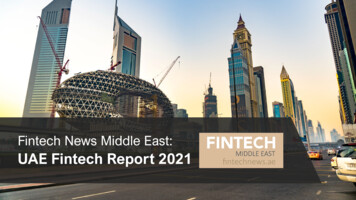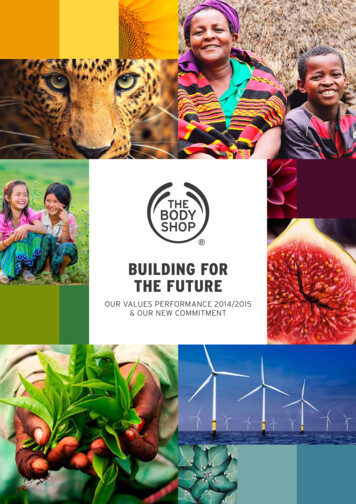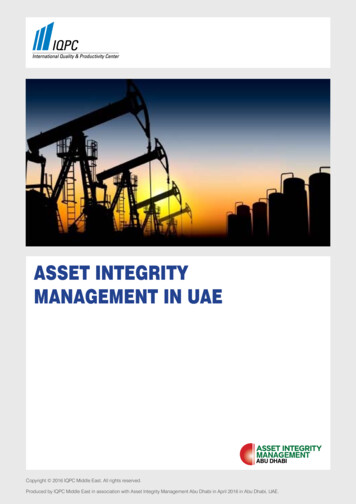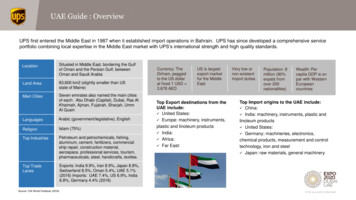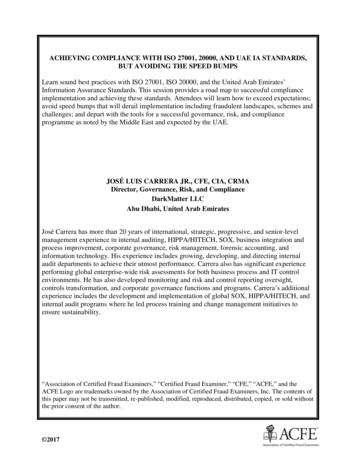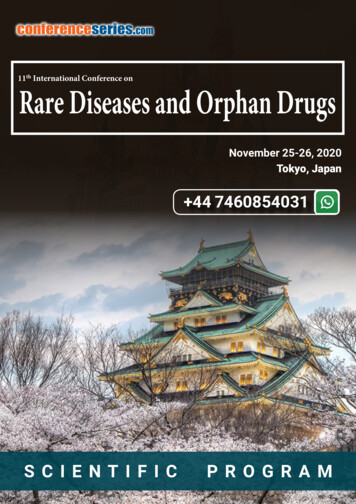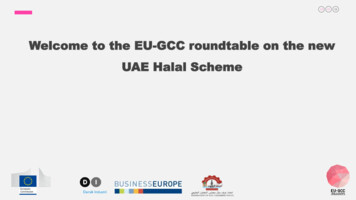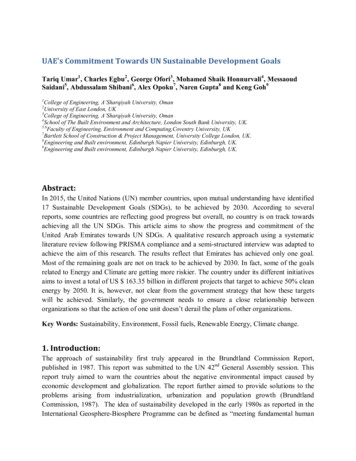
Transcription
UAE’s Commitment Towards UN Sustainable Development GoalsTariq Umar1, Charles Egbu2, George Ofori3, Mohamed Shaik Honnurvali4, MessaoudSaidani5, Abdussalam Shibani6, Alex Opoku7, Naren Gupta8 and Keng Goh91College of Engineering, A’Sharqiyah University, OmanUniversity of East London, UK3College of Engineering, A’Sharqiyah University, Oman4School of The Built Environment and Architecture, London South Bank University, UK.5,6Faculty of Engineering, Environment and Computing,Coventry University, UK7Bartlett School of Construction & Project Management, University College London, UK.8Engineering and Built environment, Edinburgh Napier University, Edinburgh, UK.9Engineering and Built environment, Edinburgh Napier University, Edinburgh, UK.2Abstract:In 2015, the United Nations (UN) member countries, upon mutual understanding have identified17 Sustainable Development Goals (SDGs), to be achieved by 2030. According to severalreports, some countries are reflecting good progress but overall, no country is on track towardsachieving all the UN SDGs. This article aims to show the progress and commitment of theUnited Arab Emirates towards UN SDGs. A qualitative research approach using a systematicliterature review following PRISMA compliance and a semi-structured interview was adapted toachieve the aim of this research. The results reflect that Emirates has achieved only one goal.Most of the remaining goals are not on track to be achieved by 2030. In fact, some of the goalsrelated to Energy and Climate are getting more riskier. The country under its different initiativesaims to invest a total of US 163.35 billion in different projects that target to achieve 50% cleanenergy by 2050. It is, however, not clear from the government strategy that how these targetswill be achieved. Similarly, the government needs to ensure a close relationship betweenorganizations so that the action of one unit doesn’t derail the plans of other organizations.Key Words: Sustainability, Environment, Fossil fuels, Renewable Energy, Climate change.1. Introduction:The approach of sustainability first truly appeared in the Brundtland Commission Report,published in 1987. This report was submitted to the UN 42nd General Assembly session. Thisreport truly aimed to warn the countries about the negative environmental impact caused byeconomic development and globalization. The report further aimed to provide solutions to theproblems arising from industrialization, urbanization and population growth (BrundtlandCommission, 1987). The idea of sustainability developed in the early 1980s as reported in theInternational Geosphere-Biosphere Programme can be defined as “meeting fundamental human
needs while preserving the earth natural environment” (IGBP, 1999). Since the earth's populationis increasing, it is putting pressure on the earth’s resources. According to the World EconomicForum, it is estimated that food production will need to double by 2050 to feed 10 billion peopleon the earth (WEF, 2018). Today, sustainability has three essential pillars includingenvironmental protection, social development, and economic growth and sustainabledevelopment can be been defined as a development that meets the needs of the present withoutcompromising the ability of future generations to meet their own needs (Sachs, 2015). The needfor sustainable development is truly recognized by all countries and thus in 2015; the UN is ableto introduce seventeen SDGs to be achieved by 2030 (UN-SDG, 2015). These goals along withits target and leading indicators that help to assess the progress of each goal are summarized inappendix 1. Most of the UN SDGs are closed to the engineering profession or in other words, theengineering profession and community have a wider role to achieve these goals. Manyprofessional engineering organizations have already incorporated the requirement of sustainabledevelopment in professional engineering practices (Cruickshank and Fenner, 2007; Head, 2009).For instance, in 1994, the American Association of Engineering Societies issued a statementtitled “The Role of the Engineer in Sustainable Development” which proclaimed that sustainabledevelopment requires “dramatic changes in the culture of engineering (McIsaac and Morey,1998). Similarly, the Institution of Civil Engineers in the United Kingdom has incorporated the‘Sustainable Development’ as one of the attributes which need is mandatory for CharteredEngineer registration. Under this attribute, the candidate required to demonstrate, (i) a soundknowledge of best practice in sustainable development, (ii) manage engineering activities in away that contributes to sustainable development and (iii) lead continuous improvement insustainable development (ICE member attributes, 2019).There has been some significant progress on the UN SDGs made globally as reflected in theSDGs Report for 2018, however, some commitment towards some goals has also been droppedwhich may have an impact on the overall achievement by 2030 on those specific goals (TSDGR,2018). For instance, some goals and indicators reflect good progress at a specific country level.For example, in the United States, the annual mean level of fine particulate matter (PM2.5)dropped to 9 micrograms per cubic meter, which was 15.7 micrograms per cubic meter in 2016(EPA, 2017). On the other hand, the performance of some goals and their indicators has droppeddown when compared at the global level. For instance, the progress of the goal 6, which aims to“ensure availability and sustainable management of water and sanitation for all” reflect that thefunding commitments to the water sector dropped by more than 25% from 2012 to 2016.Similarly, the progress of the Goal 11, which is related to sustainable cities and communities,reflect that between 2000 and 2014, the proportion of the world’s urban population living inslums declined by 20% (from 28.4 to 22.8%). However, the rate of new home constructionlagged far behind the rate of urban population growth, and the number of people living in slumsactually increased from 807 million to 883 million over this period. The majority of those livingin slums are located in three regions: Eastern and South-Eastern Asia (332 million), Central andSouthern Asia (197 million) and sub-Saharan Africa (189 million). Similarly, Data from 214
cities or municipalities in 103 countries show that about three-quarters of municipal solid wastegenerated is collected (figure 1). In sub-Saharan Africa, less than half of all municipal solidwaste generated is collected, with adverse effects on the health of residents. Moreover, evenwhen waste is collected, it is often not treated and disposed of in a sustainable andenvironmentally sound manner. Managing such waste continues to be a major challenge facingurban areas in several regions. Considering the example of the main city (Dubai) of the Emirates,the World Bank data reveals that the total municipal solid waste generated in one year in this cityis 2,689,808 tonnes/year (WB, 2019). Municipal solid waste is one part of the total waste, theactual waste generated in Dubai could be several times more than municipal solid waste. Thedata further reveals that only 25% of municipal solid waste in Dubai is recycled, which representa small portion of the total waste generated in Dubai.Considering the three main sustainability pillars, the performance of the Emirates in differentareas is not at a satisfactory level. For instance, electricity consumption in the Emirates hasincreased from 681.162 kWh per capita in 1971 to 11,088.35 kWh per capita in 2014 (IEA,2014). This sharp increase in the consumption could be justified considering the reasons thatnow many peoples have access to electricity and there are now many new industrials units thatare now run by electricity, however, the country still depends on the conventional resources suchas oil, gas, and coal to produce electricity (IEA, 2016). The current CO2 emission in Emirates isquite high. For instance, the CO2 emission in Sweden is 4.478 tonnes per capita, while inEmirates it stands at 22.94 tonnes per capita (CDIAC, 2017). The high levels of electricityconsumption and greenhouse gas emission have also affected the Emirates' air quality. Thecurrent value of the atmospheric particulate matter (PM2.5) in Emirates is 40.91 micrograms percubic meter while the same value in Denmark is 10.03 micrograms per cubic meter only (Cohenet al., 2017). Such air quality can highly affect the health of the Emirates population. The worldHealth Orgaznaition (WHO, 2018) guidelines on air quality recommend a value of 10micrograms per cubic meter for PM2.5. The current value of PM2.5 in Emirates is four timesmore than the recommended values. There are still challenges in the Gulf Cooperation Council(GCC) countries to adopt the available renewable energy resources to meet some of its electricityrequirements. These challenges are associated with policies and regulations, manpowerexperience and competencies, renewable energy education, public awareness, costs and incentivefor renewable energy, and government commitment (Umar et al., 2019-a). The constructionindustry in most of the GCC countries is at a peak as the region is improving its infrastructures(Umar, 2017-a; Umar et al., 2019-b). The current capacity of Emirates cement production standsat 40.7 million tonnes, which is double than its own requirement. This extra cement is normallyexported to the countries including, Oman, Egypt, and some countries in Africa (BBB, 2015).While cement is the best bonding material and it also helps to sustain the Emirates industry andeconomy, at the same time it is not environment-friendly. According to the estimate presented byUmar et al., (2019-c), one tonne of cement produces the same amount of CO2. Similarly, theconstruction waste in Emirates is accounted for almost 70% of the total solid waste generated inthe country (Swain, 2018). Such waste is simply dumped in different dumpsite or landfill stations
which increase the greenhouse gas emission and create environmental issues (Umar et al., 2019d). To achieve the UN SDGs related to energy and sustainable production and consumption,emirates seriously need to focus on the issue related to the construction industry. Overall, thesituation over the GCC countries is not much different from each, the next section, therefore,provides an overview of the GCC region in relation to different UN SDGs.World74Australia and New Zealand94Europe and Northern America90Latin America and the Caribbean80Northern Africa and Western Asia74Eastern and South-Eastern Asia72Central and Southern Asia67Sub-Saharan Africa43020406080100municipal solid waste generation (%)Figure 1: Proportion of the municipal solid waste generated that is collected, 2001–2015(data from 214 cities/municipalities in 103 countries) – (Based on TSDGR, 2018)1.1 An Overview of the GCC Region:According to the SDG Index and Dashboards Report, no country is on track towards achievingall the UN SDGs while countries with conflicts are experiencing the sharpest reversals in theirprogress (SDGIDR, 2018). At the outlook of the Gulf countries, they are normally recognized ashigh consumer of the earth resources and as the main contributor to CO2 emission, and their lowprogress towards SDGs, however, some countries in gulf region have recently demonstrated theircommitment towards these goals (Salahuddin and Gow, 2014; UAESDG, 2019). In relation tohigh consumption of natural resources, a study conducted by Umar and Wamuziri (2016), whileexploring the wind and solar energy resources in Oman, particularly noted that energyconsumption in GCC (Gulf Cooperation Council) is more than the double of the consumption inChina and United Kingdom. Due to the high level of energy consumption, the average CO2emission per capita is GCC countries is ( 25.36 Tonne) is three times greater than the CO2emission per capita in China ( 7.5 Tonne) and almost four times greater than the CO2 emissionper capita in United Kingdom ( 6.5 Tonne) – figure 2. Some research studies noted that muchof the electricity in Oman is produced from oil and gas, which are neither renewable norsustainable therefore these studies explore the geothermal, and biomass and solar resources for
electricity production in Oman (Honnur Vali et al., 2018; Umar, 2018-a; Umar, 2018-b; Umar,2017-b; Honnurvali et al., 2018). On the other side, countries such as the United Kingdom haveraised the percentage (%) of the total energy consumption from renewable sources to 8.6%which was only 1.3% in 2000 (ONS, 2017). The global commitment towards sustainable energyis well demonstrated by Umar and Egbu (208-a), however, they also noted that GCC countrieshave not yet submitted their intended action plan required under the UN Framework Conventionon Climate Change (UNFCC, 1992). The UN under Goal 7 aims to reduce the adverse per capitaenvironmental impact of cities, including paying special attention to air quality and municipaland other waste management. In relation to this goal, the overall gulf region's progress is,however not satisfactory. The annual solid waste generation in the Gulf region has exceeded 150million tonnes. GCC countries including Saudi Arabia, Kuwait, United Arab Emirates, Qatar,and Bahrain featuring among the world’s top ten per capita waste generators (figure 3). Lack oflegal and institutional frameworks has been a major stumbling block in the progress of the wastemanagement sector (Zafar, 2018). The per capita production of municipal waste in top GCCcities, such as Riyadh, Doha, Abu Dhabi, and Dubai, is more than 1.5 kg per day which is amongthe highest worldwide (Zyoud et al., 2015). Across the region, the recycling sector isunderdeveloped and hardly 10–15 percent of the waste is recycled (Zafar, 2015).The above discussion clearly reveals that GCC countries' progress towards UN SDGs could becomparatively slow. This article, therefore, aims to explore the current progress of the regionusing a qualitative research approach. The progress of the United Arab Emirates which is one ofthe modern and advanced member countries of the GCC is reported in this article. Although eachyear the report issued by the UN provides an overall review of the SDGs in a global context, thispaper explores the progress of Emirates, rich in oil and gas reserves, towards UN SDGs. Thisinsight is not only helping to understand the Emirates' progress and commitment towards thesegoals but also helps to understand the GCC region's overall situation in relation to UN SDGs.The semi-structured interview held with the engineering professionals in the country explains thethought of the engineering community and highlight the challenges being faced by theserespondents in the area of sustainability.The next section of the article explains the research methodology adopted in this research.
itElectriccity Consumttion19592.232 15213.42(kWh/Capita)CO2 Emission Per bEmiratesCO2 Emission Per Capita (Tonne)Electriccity Consumttion (kWh/Capita)2500006553.52 15309.429 9444.216 11263.53215.445.419.523.3353302.5Population (Million)252201.5151100.550Population (Million)Municipal Solid 1.81.70Municipal Solid Waste (Kg/Person/Day)Figure 2: Electricity Consumption and CO2 Emission Per Capita in Selected GCCCountries (Based on WB, 2014-a, WB, 2014-b)
Figure 3: GCC Population VS Municipal Waste Generation (Based on Zafar, 2018)2. Research Methodology:The main aim of this research was to explore the progress of the GCC region towards theachievement of the UN SDGs. Apart from this, the paper also aimed to find the perspective ofthe engineering professionals on the challenges and opportunities involved in the SDGs. Thiswas accomplished using a qualitative research method as opposed to a quantitative method.Concisely, the difference between these two research methods is given below (Bryman, 2016).Quantitative research stresses quantification in data collection and examination. It takes adeducible way to the connection among theory and research and stress are kept on theconfirmation of theories. The quantitative research method integrates the norms and practices ofthe natural scientific model and positivism. It views social phenomena as an outer objective truth(Cooper et al., 2006). On the other side, a qualitative research approach stresses on words andcontexts despite quantification in data collection (Opdenakker, 2006). It stresses an introductoryapproach in the relationship between theory and research and focus is settled on the formation oftheories. The majority of the researchers prefer to incorporate both qualitative and qualitativemethods, referred to as combined research methods and highly appreciated in the literature dueto certain advantages (Umar and Egbu, 2018-b). Since the research presented in this paper isexploratory in nature, a qualitative method consists of a systematic literature review and a semistructured interview was considered as the most suitable method to collect the data.To collect the relevant data, an internet search was employed. Since the UN SDGs were adoptedin 2015, therefore the search period was kept from 2015 to 2019. Two of the major databasesincluding Scopus and Web of Science were taken on board. Apart from these databases, googlesearch engine was also used to search the relevant report published by local or internationalorganizations. Different keywords such as “UN SDGs”, “UAE SDGs”, “Sustainability inEmirates” and “Sustainability Progress in UAE” were used for the search purpose. For eachkeyword, the first 25 items were considered to be further refined using the screening process.This approach was however only applied to the results obtained from the Google search engine.The approach was adopted due to the fact that in most cases the search engines such as Googleprovide a large number of the result. It is almost not possible to consider such a large number inany study. Thus, it was considered reasonable that for each item, the first 25 results will be usedfor further screening.To ensure that a systematic review process is adopted in this study, the research method for thereview was guided by Preferred Reporting Items for Systematic Reviews and Meta-Analyses(PRISMA). The PRISMA guidelines required to follow a four steps process to include the finalof studies in the systematic review and meta-analysis (Moher et al., 2009). The data anddocuments found in the search were screened using different screening criteria. The criteria forthe research paper were that it should be written in English and the keywords should be in thetitle, abstract or in the keywords section. For the various reports obtained from the google searchengine, the criteria were that it should be published or created by a legitimate source and should
be relevant to the United Arab Emirates' sustainability progress. All the relevant informationeither published as a document or as a web page was considered provided that they pass thescreening process. Using this criterion, all the data and publications available from thegovernment organizations, ministries, independent government entities, independent nongovernment organizations and research publications relevant to the area of the study wereconsidered. Considering the scope of the work and keeping in mind that the different databasesand search engine like Google may result into a large volume of the documents, which could bedifficult to screen, the selection of the items were only kept to the first 25 documents from eachkeyword and search engine. This criterion was, however, not applied to the search obtained fromthe Scopus and Web of Science. Descriptive analysis was conducted to compare the Emirates'progress with other countries both at the global level and regional level.For the semi-structured interview, a set of questions was developed and validated on a relativelysmall sample. The purpose of this exercise is to find the thoughts of the engineering communityon SDGs working in Emirates. The criteria for selecting the respondents were set as theparticipants should have at least 15 years of experience in Emirates and should have sufficientknowledge and experience of engineering sustainability practice at a local context. Only theparticipants with academic background and experience background of Civil and Environmentalengineering were considered for this purpose. A similar approach was also adopted by Umar etal., (2019) for selecting the respondents for a study related to renewable energy in the GCCregion. To search the relevant respondents, their profile was searched and screened using theirorganization's websites. The organization's name and websites were obtained from the UAEcontractors Association website (UAE-CA, 2019). Personal links, connections, LinkedIn andWhatsApp groups were also used to identify suitable candidates for this interview. Finally, a listof 20 respondents was developed. A study conducted by Umar (2019) noted that the sample sizefor most of the research studies involves semi-structured interviews that are roughly equal to 20.The respondents were contacted through emails asking for their cooperation in the study. A totalof 10 respondents made themselves available for the interview. All the participants in thisinterview were male. The interview was conducted telephonically. Although the number ofparticipants in this interview was comparatively low, however, there are a number of exampleswherein such exploratory studies were conducted with much smaller respondents (Umar, 2018-c;Umar and Egbu, 2018-c). The interview questions are appended in Appendix II.The next section of the paper provides the result and discussion derived from the adoptedresearch methodology.3. Results and discussion:When the first term “UAE SDGs” was used in the Google search engine, it has given a totalsearch result of 4,090,000. Similarly, the term “Sustainability in Emirates” has given a totalsearch result of 47,600,000. The last term “Sustainability Progress in UAE” provided a totalsearch result of 5,480,000. The first 25 results of the Google search engine using the respectivekeywords were considered for further screening process (figure 4). The raw number of the resultbecomes 300 (N 300) as explained in equation 1. At the first screening process stage, theduplicate items/records equal to 109, were removed. Thus the eligible items/records for
screening purposes were 191 (N 191). At this stage, the screening criteria as described in themethodology section was applied, which resulted in the removal of 63 items/records (N 128).At the eligibility stage, a total of 65 items were considered not to be eligible for furtherconsideration. Thus the final items/records left for the qualitative and quantitative analysis were,therefore, stood at 63 (N 63). The United Arab Emirates' progress towards UN SDGs,extracted from these items/records (N 63) is highlighted in the next section.The total number of records (N) Number of keywords x 25 x 1 database results Equation 1.Wherein;Number of keywords 4Databases results (Scopus 111, Web of Science 89; total 111 89 200)Thus;N 4 x 25 200 300
IdentificationItems / Records Identified ThroughDatabase Searching (n 57,170,000),record considered (n 300)Additional Items / Records IdentifiedThrough Other Sources(n 0)EligibilityScreeningItems / Records After Duplicates Removed(n 191)Items / Records Screened(n 191)Items / Records Excluded(n 63)Full-Text Articles / itemsAssessed For Eligibility(n 128)Full-Text Articles / itemsExcluded(n 65)IncludedItems / Studies Included InQualitative Synthesis(n 63)Items / Studies Included InQuantitative Synthesis(Meta-Analysis)(n 63)
Figure 4: PRISMA Process Adopted in the Research3.1. Emirates’ Progress Towards UN SDGs:The first progress report and ranking report on the UN SDGs issued in 2015, which consideredthe progress of 34 countries, indicates that there was no country in the list from the GCC region.This was due to the fact that there was limited or no data from this region to be considered in thereport, and secondly, this report aimed to assess the rich countries that they are ready towardsUN SDGs (Kroll, 2015). In the second global report and raking of UN SDGs, the United ArabEmirates was ranked 55th with a mean score of 63.6 (0 – 100) (Sachs et al., 2016). A total of 149countries were considered in this ranking while a total of 44 countries were excluded from thisranking due to several reasons. Regionally, Qatar was placed on the top with a global rankingand score of 49 and 68.5 respectively. Bahrain was excluded from SDG Index and Dashboardsdue to insufficient data. Overall, at the regional level Emirates was able to secure the secondposition in the GCC region based on its global score and ranking (figure 5). The 2017 SDGsIndex and Dashboards which considered a total of 157 countries around the world, ranked theUnited Arab Emirates at 77 with a total global index score of 66.0 (0 – 100) (Sachs et al., 2017).Overall the raking of the United Arab Emirates as compared with 2016 raking has been declined,however, at the same time the global index score of the country has increased from 63.6 to 66.0.Clearly, the ranking is declined due to the fact that in 2016, the number of countries which wereconsidered in the raking was 149, while in 2017, this number was 157. At the same time, thisalso reflects that some countries have achieved good progress compared with the United ArabEmirates. At the GCC region level, the United Arab Emirates, based on its global ranking andglobal index score, was able to take the first position from Qatar in 2017 as shown in figure 6.
701006050SDG Global Rank80406030402020100SDG Global RankGlobal Index ScoreGlobal Index .008064.006063.004062.002061.000SDG Global RankGlobal index Figure 6: Global SDG Index and Ranking of GCC Countries (2017)60.00Global index scoreSDG Global RankFigure 5: Global SDG Index and Ranking of GCC Countries (2016)
12070100686680646062406020580SDG Global RankGlobal index scoreGlobal index scoreSDG Global RankThe 2018 SDGs Index and Dashboards indicate that globally, the United Arab Emirates rankingstood at 60 with a global index score of 69.2 (0 – 100). Both based on the global ranking andindex score Emirates was leading the GCC region as shown in figure 7 (Sachs et al., 2018).Similarly, both the ranking and index score, as compared with the last year, has been improvedwhich reflects that overall the country is on the track towards achieving the UN SDGs. Theglobal index data shows that the score of the United Arab Emirates is gradually increasing whichwas 63.6 in 2016, 66.0 in 2017 and 69.2 in 2018. The mean index score of Emirates is the pastthree years was 66.26 on a scale of 0 – 100. On average, there has been an improvement in theEmirates index score of 8.8% in the whole three years or 2.94% per re 7: Global SDG Index and Ranking of GCC Countries (2017)To effectively reflect the progress of the Emirates on each UN SDGs, the mean score of eachseventeen goals are considered. The data reflects that the United Arab Emirates has alreadyachieved Goal 1 (No Poverty, score 100) and further maintaining the same trend towardskeeping this achievement. These results are based on Emirates citizens, however, more than 80%of the UAE population are foreigners and the conditions of these workers are alwaysquestionable (Strabac et al., 2018; WPR, 2019). In relation to Goal 1, Emirates, therefore, needsto focus on the foreign workers' conditions and needs to ensure that they have a safe and healthyworking environment. There are a number of studies that reflect the wages of workers are basedon their nationalities. In other words, western national workings in the UAE are getting moresalaries than workers from Asian countries. Thus, in reality, considering the whole population ofthe Emirates, which includes Emiratis and foreigners, Goal 1 (No Poverty) is not yet achieved.
Similarly, in relation to Goal 2, it is important to note that bio-capacity per person in the UAEwhich was 4.7 in 1980 has reduced to 0.6 in 2015. This has affected the ecological footprint andthe value is increased from 6.5 (1980) to 9 (2015) (GFN, 2019). While the National FoodSecurity Strategy aims to bring the country to the first position in the global food security indexby 2051, which currently stood at 31st position (NFSS, 2019; GFSI, 2018). When it comes tonatural resources and resilience, Emirates currently stood at the last (113th) in the Global FoodSecurity Index. The discussion reveals that Goal 2 (Zero Hunger) is at risk and thus seriousefforts are required to achieve this goal in the due course of time.As discussed in section 1, the atmospheric particulate matter in UAE is quite high that can affectthe population health and can affect the achievement of Goal 3. Apart from this, the normalworking hours for the private sector as per Article 65 of the UAE Labour Law are eight hours perday or 48 hours per week. The working hours per day can be increased up to 9 hours per daywith the approval of the Ministry of Human Resources and Emiratization (UAE-Labour Law,1980). The number of deaths in road accidents in the UAE is also quite alarming. The statisticspublished on the government website indicate that in 2016 there were 725 deaths, 560 majorinjuries, 3,110 medium injuries, and 3,011 minor injuries.
8Engineering and Built environment, Edinburgh Napier University, Edinburgh, UK. 9Engineering and Built environment, Edinburgh Napier University, Edinburgh, UK. Abstract: In 2015, the United Nations (UN) member countries, upon mutual understanding have identified 17 Sustainable Development Goals (SDGs), to be achieved by 2030. According to several

